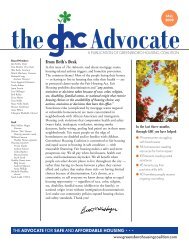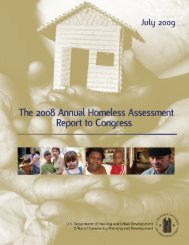Ten Year Plan to End Chronic Homelessness - Greensboro Housing ...
Ten Year Plan to End Chronic Homelessness - Greensboro Housing ...
Ten Year Plan to End Chronic Homelessness - Greensboro Housing ...
You also want an ePaper? Increase the reach of your titles
YUMPU automatically turns print PDFs into web optimized ePapers that Google loves.
III. Background: A New Approach<br />
“Five years ago, the notion of cities having ten year plans <strong>to</strong> end homelessness<br />
was naïve and risky. No one thought it was possible. But the new research and<br />
new technologies have created such movement and innovation on this issue that<br />
it may now be naïve and risky not <strong>to</strong> have such a plan.”<br />
—Philip Mangano, Executive Direc<strong>to</strong>r<br />
U.S. Interagency Council on <strong>Homelessness</strong><br />
<strong>Homelessness</strong> is a problem in every community. Nationally, approximately<br />
1,000,000 persons are homeless on any given night, and as many as 2.5 million<br />
<strong>to</strong> 3 million people experience homelessness over the course of a year.<br />
In Guilford County, over 1,200 people were homeless on January 24, 2007.<br />
<strong>Homelessness</strong> can be temporary, due <strong>to</strong> job loss, domestic violence, or natural<br />
disasters. Or it can be chronic, a long term situation usually linked <strong>to</strong><br />
disabilities such as mental illness, substance abuse, or physical disabilities.<br />
Anyone can become homeless; the disabled are more likely <strong>to</strong> remain<br />
homeless. National studies have shown that 75-80% of those who become<br />
homeless are homeless for two months or less, while another 10% remain<br />
homeless for approximately 6 months. Only about 10 - 15% remain homeless<br />
for more than a year, and these chronically homeless individuals typically<br />
utilize over 50% of emergency shelter resources. In Guilford County,<br />
over 200 of the persons counted in January 2007 were chronically homeless,<br />
remaining without a home for a year or more, or continuously cycling<br />
in and out of homelessness for years without reaching housing stability.<br />
The majority of people who become homeless in Guilford County are<br />
assisted by a full “Continuum of Care” which moves them from emergency<br />
shelter through transitional housing <strong>to</strong> permanent housing. Last<br />
year, 243 people moved from transitional living facilities in<strong>to</strong> permanent<br />
housing situations.<br />
But like many communities across the nation, Guilford County has struggled<br />
in its efforts <strong>to</strong> help those for whom homelessness has become a<br />
chronic condition. For these individuals, the system isn’t working.<br />
In recent years, new and innovative ideas in some cities have begun <strong>to</strong> dramatically<br />
reduce the number of persons remaining chronically homeless.<br />
Most of these are based on the “<strong>Housing</strong> First” approach, which emphasizes<br />
placing homeless person in safe, permanent housing first, and then ensuring<br />
their access <strong>to</strong> the services necessary <strong>to</strong> remain housed. This approach<br />
recognizes housing as a primary human need, and studies have shown that<br />
stability in housing increases positive outcomes for mentally ill persons.<br />
In New York, an organization called Pathways has developed a program of<br />
housing and services based on this “<strong>Housing</strong> First” concept that over the<br />
past five years has had an 88% success rate in keeping the chronically<br />
homeless housed. A University of Pennsylvania study of homelessness in<br />
New York, the most definitive done <strong>to</strong> date, tracked 4,679 homeless persons<br />
with psychiatric disabilities, and a control group with similar psychiatric<br />
disabilities, over a four year period. The study found that a homeless<br />
mentally ill person in New York City used an average of $40,449 in public<br />
services over the course of a year. When placed in service –enriched housing,<br />
his or her use of public services decreased by an average of $12,145 per<br />
year (Culhane et al, 2002). Since adopting this “<strong>Housing</strong> First” approach,<br />
New York has documented a 13% decrease in chronic homelessness. Other<br />
communities which have adopted this “<strong>Housing</strong> First” approach have also<br />
documented dramatic decreases in chronic homelessness. Denver has<br />
shown an 11% decrease; San Francisco a 28% decrease; Portland a 20%<br />
decrease, Miami a 30% decrease. Closer <strong>to</strong> home, Raleigh has shown an<br />
11% decrease, Asheville has shown a 26% decrease (statistics from U.S.<br />
Interagency Council on <strong>Homelessness</strong>). “<strong>Housing</strong> First” works.<br />
The success of these efforts has spurred the federal government, with<br />
bipartisan consensus, <strong>to</strong> encourage communities <strong>to</strong> re-think their current<br />
systems, and address them <strong>to</strong>ward ending chronic homelessness and<br />
reducing all homelessness with these new techniques.<br />
The U.S. Conference of Mayors, National Association of Counties,<br />
National League of Cities, and National Governor’s Association have all<br />
endorsed this concept and encouraged their members <strong>to</strong> undertake a planning<br />
process <strong>to</strong> create a <strong>Ten</strong> <strong>Year</strong> <strong>Plan</strong> <strong>to</strong> <strong>End</strong> <strong>Homelessness</strong>. The Guilford<br />
County Board of Commissioners, the City Council of High Point, and the<br />
City Council of <strong>Greensboro</strong> have passed resolutions supporting this Task<br />
Force review and planning process for our community.<br />
Where We Are Now<br />
The Task Force has examined data from point in time counts, housing<br />
inven<strong>to</strong>ries, and qualitative surveys, and also conducted Town Hall meetings<br />
and focus groups <strong>to</strong> obtain community insight in<strong>to</strong> the characteristics<br />
of homelessness in Guilford County.<br />
Point in time counts conducted by the Homeless Prevention Coalition<br />
of Guilford County have detailed the numbers of the homeless population<br />
in Guilford County. The following chart shows the data as of<br />
January 24, 2007.<br />
Guilford Homeless Population and <strong>Housing</strong> Data (1/24/07)<br />
In Emergency Number of In Transitional Number of Unsheltered Total<br />
Shelter Emergency <strong>Housing</strong> Transitional<br />
Beds<br />
Beds<br />
Persons in Families 132 122 140 205 11 283<br />
Single Persons 272 258 319 361 113 692<br />
Total 404 380 459 566 124 987<br />
<strong>Chronic</strong>ally homeless 142<br />
(included above) 70 212<br />
As part of the point in time count, an inven<strong>to</strong>ry was also undertaken of<br />
existing permanent supportive housing (persons residing in permanent<br />
housing are not considered homeless by federal standards, so are not<br />
included in the “homeless” population count). Guilford County’s<br />
Permanent Supportive<br />
<strong>Housing</strong> Beds<br />
inven<strong>to</strong>ry of permanent supportive housing and unmet need for<br />
permanent supportive housing based on U.S. Department of <strong>Housing</strong><br />
and Urban Development calculations is shown in the following chart.<br />
Unmet need for<br />
PSH Beds<br />
For persons in families 119 155<br />
For single persons 48 403<br />
Total 167 558<br />
Need for <strong>Chronic</strong>ally homeless 263<br />
(included in singles, above)<br />
4<br />
5




